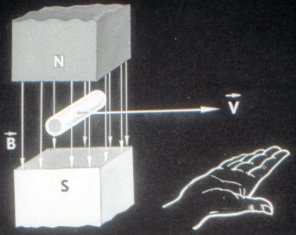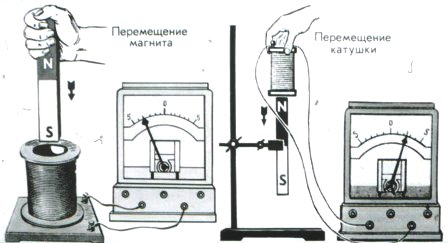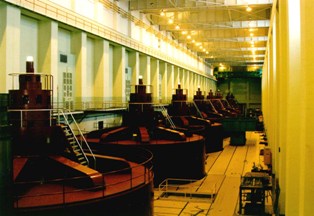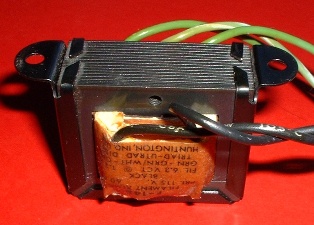Electromagnetic induction
The appearance in the induction of the EMF of the conductor
If you put magnetic field wire and move it so that it crosses the field lines as it moves, then the wire will have electromotive forceCalled EMF Induction.
An induction EMF will occur in the conductor even if the conductor itself remains stationary and the magnetic field will move, crossing the conductor with its lines of force.
If the conductor in which the induction EMF is induced is closed to any external circuit, then under the action of this EMF a current will flow through the circuit, the so-called induction current.
The phenomenon of EMF induction in a conductor when it crosses its magnetic field lines is called electromagnetic induction.
Electromagnetic induction is the reverse process, that is, the conversion of mechanical energy into electrical energy.
The phenomenon of electromagnetic induction is widely used in electrical engineering… The device of various electrical machines is based on its use.
The magnitude and direction of the EMF induction
Let us now consider what will be the magnitude and direction of the EMF induced in the conductor.
The magnitude of the induction EMF depends on the number of lines of force crossing the wire per unit of time, i.e. on the speed of the wire's movement in the field.
The magnitude of the induced EMF is directly proportional to the speed of movement of the conductor in a magnetic field.
The magnitude of the induced EMF also depends on the length of that portion of the wire that is crossed by the field lines. The larger the portion of the conductor crossed by the field lines, the greater the induced emf in the conductor. Finally, the stronger the magnetic field, that is, the greater its induction, the greater the EMF in the conductor crossing this field.
Thus, the EMF value of an induction occurring in a conductor when it moves in a magnetic field is directly proportional to the induction of the magnetic field, the length of the conductor and the speed of its movement.
This dependence is expressed by the formula E = Blv,
where E is the induction EMF; B — magnetic induction; I is the length of the wire; v is the velocity of the wire.
It must be firmly remembered that in a conductor moving in a magnetic field, EMF of induction occurs only if this conductor is crossed by the magnetic field lines of the field. If the conductor moves along the field lines, that is, it does not cross, but seems to slide along them, then no EMF is induced in it. Therefore, the above formula is valid only when the wire moves perpendicular to the magnetic field lines.
The direction of the induced emf (as well as the current in the wire) depends on the direction in which the wire is moving. There is a right-hand rule for determining the direction of the induced EMF.
If you hold the palm of your right hand so that the magnetic field lines enter it, and the bent thumb would indicate the direction of movement of the conductor, then the extended four fingers would indicate the direction of action of the induced EMF and the direction of the current in the conductor.

Right hand rule
EMF induction in the coil
We have already said that in order to create an EMF of induction in a wire, it is necessary to move either the wire itself or the magnetic field into a magnetic field. In both cases, the wire must be crossed by the field's magnetic field lines, otherwise no emf will be induced. The induced emf, and hence the induced current, can occur not only in a straight wire, but also in a wire twisted into a coil.
When moving inside coils of a permanent magnet, an EMF is induced in it due to the fact that the magnetic flux of the magnet crosses the turns of the coil, that is, in the same way as when moving a straight wire in the field of a magnet.
If the magnet is slowly lowered into the coil, then the EMF arising in it will be so small that the needle of the device may not even deviate. If, on the contrary, the magnet is quickly inserted into the coil, the deflection of the arrow will be large. This means that the magnitude of the induced EMF and, accordingly, the strength of the current in the coil depends on the speed of the magnet, that is, on how quickly the field lines of the field cross the turns of the coil. If now, alternately, initially a strong magnet and then a weak magnet are inserted into the coil at the same speed, then you will notice that with a strong magnet the needle of the device will deviate at a greater angle.It means, the magnitude of the induced EMF and, accordingly, the strength of the current in the coil depends on the magnitude of the magnetic flux of the magnet.
Finally, if the same magnet is introduced at the same speed, first into a coil with a large number of turns, and then with a much smaller number, then in the first case the needle of the device will deviate by a greater angle than in the second. This means that the magnitude of the induced EMF and, accordingly, the strength of the current in the coil depends on the number of its turns. The same results can be obtained if an electromagnet is used instead of a permanent magnet.
The direction of induction of EMF in the coil depends on the direction of movement of the magnet. How to determine the direction of EMF of induction, says the law established by E. H. Lenz.
Lenz's law of electromagnetic induction
Any change in the magnetic flux inside the coil is accompanied by the appearance of an EMF of induction in it, and the faster the change of the magnetic flux penetrating the coil, the greater the EMF in it.
If the coil in which the induction EMF is created is closed to an external circuit, then an induction current flows through its turns, creating a magnetic field around the wire, due to which the coil turns into a solenoid. It turns out that the changing external magnetic field induces an induced current in the coil, which in turn creates its own magnetic field around the coil—the current field.
Studying this phenomenon, E. H. Lenz established a law that determines the direction of the induction current in the coil and, accordingly, the direction of the induction EMF.The emf of induction occurring in the coil when the magnetic flux changes in it creates a current in the coil in such a direction that the magnetic flux of the coil created by this current prevents the external magnetic flux from changing.
Lenz's law is valid for all cases of current induction in wires, regardless of the shape of the wires and how the change in the external magnetic field is achieved.

When the permanent magnet moves relative to the wire coil connected to the terminals of the galvanometer, or when the coil moves relative to the magnet, an induced current is generated.
Induction currents in massive conductors
The changing magnetic flux is capable of inducing an EMF not only in the turns of the coil, but also in massive metal conductors. Penetrating the thickness of a massive conductor, the magnetic flux induces an EMF in it, which creates induction currents. These so-called eddy currents spread over a solid wire and are short-circuited in it.
The cores of transformers, magnetic cores of various electrical machines and devices are only those massive wires that are heated by the induction currents arising in them. This phenomenon is undesirable, therefore, in order to reduce the magnitude of the induction currents, the parts of electrical machines and the core of the transformer are not massive, but consist of thin sheets insulated from each other with paper or a layer of insulating varnish. Therefore, the path of propagation of eddy currents along the mass of the conductor is blocked.
But sometimes in practice eddy currents are also used as useful currents. The use of these currents is based on, for example, the work induction heating furnaces, electricity meters and the so-called magnetic dampers of moving parts of electrical measuring instruments.
See also: The phenomenon of electromagnetic induction in paintings


